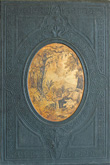The Origin of the Publisher’s Cloth Binding
Rapid changes to Britain’s social structure throughout the 19th century led to a significant increase in literacy and the demand for reading material. This, combined with the new educated elite’s capacity to purchase books and the technical developments in printing, including the steam-driven rotary press, led to significant changes in the way the book trade was organised.
In the 1820s publishing began to emerge as a separate occupation, carried out by a single person or group and distinct from other activities such as bookselling. Binders now had to keep pace with the demands of individuals who could afford to have their books custom-bound in leather, plus the demands of the booksellers, as well as those of the publishers who were increasingly taking responsibility for the whole book-making process. This included the editing, printing and binding of their publications, sometimes as a single part but often the whole of an edition.
The uniform binding of a certain quantity of an edition wasn’t new to the 19th century, however, the form of publishers’ binding that was to become “the standard” was certainly a product of the technical developments of the Victorian era. The “publisher’s binding”, recognised for its cloth-covered, gilt-blocked casing, refers to a book cover manufactured in quantity which is intended to be identical, and which is applied to a whole or part of an issue bound for a publisher to sell. The fact that the cloth and boards could be assembled separately from other steps in the binding process went a long way towards addressing the increased demand for books and their speedy distribution, facilitated by the rapid development of the railways.
To market and sell their books, publishers invested in cover designs that had a high degree of artistic involvement but they also pursued far less complex designs so as to ensure affordability. Many of the designs reflected, in gilt, aspects of the book’s text or its illustrations. Sometimes the design far exceeded the quality of what lied within!
For such an important innovation then, it is difficult to believe that we have no confirmed account of which binder first introduced cloth and to which title it was first applied. Today, most evidence points to Pickering as the publisher who first suggested the use of red curtain cloth to his binder, Archibald Leighton, for the 1823 volumes of Diamond classics.












